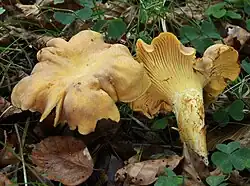Cantharellus amethysteus
| Cantharellus amethysteus | |
|---|---|

| |
| Scientific classification | |
| Kingdom: | Fungi |
| Division: | Basidiomycota |
| Class: | Agaricomycetes |
| Order: | Cantharellales |
| Family: | Cantharellaceae |
| Genus: | Cantharellus |
| Species: | C. amethysteus
|
| Binomial name | |
| Cantharellus amethysteus (Quél.) Sacc. 1887
| |
| Cantharellus amethysteus | |
|---|---|
| Ridges on hymenium | |
| Cap is flat or depressed | |
| Hymenium is decurrent | |
| Stipe is bare | |
| Spore print is white to yellow | |
| Ecology is mycorrhizal | |
| Edibility is edible | |
Cantharellus amethysteus, the amethyst chanterelle, is a species of Cantharellus from Europe.[1]
Description
Cantharellus amethysteus is an edible[2] chanterelle species with white flesh which turns yellow as it ages.
Cap: 5-10cm. Flat topped to start with depression forming. Downy texture with irregular, wavy edges. Stem: 3-4cm. Tapers downwards, often flattened or twisted. Veins/ridges: Thick and decurrent. Paler colour than the cap. Taste: Mild. Smell: Mild and pleasant, faint smell of apricots. Spore print: white to palish yellow sometimes with a pink tinge. Spores: Cylindrical to elongated ellipsoid, smooth, non-amyloid. 8-10 x 5.5-6 μm.[3]
References
- ^ "Cantharellus amethysteus in MycoBank".
- ^ "Cantharellus amethysteus, Amethyst Chanterelle mushroom". www.first-nature.com. Retrieved 2022-07-07.
- ^ Buczacki, Stefan (2012). Collins fungi guide. London: Collins. ISBN 978-0-00-724290-0. OCLC 793683235.
External links
 Media related to Cantharellus amethysteus at Wikimedia Commons
Media related to Cantharellus amethysteus at Wikimedia Commons Data related to Cantharellus amethysteus at Wikispecies
Data related to Cantharellus amethysteus at Wikispecies